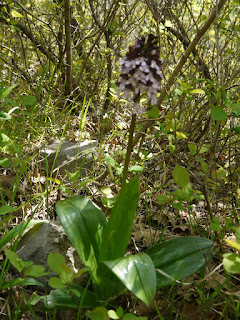Welcome
to my blog.
Most visitors to Slovenia head for Lake Bled, to enjoy the spectacular alpine region. However, there is much more to this small country, and if you venture further afield you will be treated with some fantastic walks, with beautiful, varied scenery, flora and fauna, but without the crowds and prices associated with more popular destinations.
Through these pages I am hoping to share with you some of the beautiful places I have walked in Slovenia.
Through these pages I am hoping to share with you some of the beautiful places I have walked in Slovenia.
When to visit
We have found the spring and autumn an excellent time to visit Slovenia. The weather is usually milder at these times of year. In the summer it can be very hot with thunder storms in the late afternoon. Whilst in winter it is often bitterly cold, with snow and the occasional violent storm.
In the spring you can enjoy an array of wild flowers, but tourist sites and facilities may not open until Easter. In the autumn, you can enjoy the warm, autumnal colours and the abundance of produce. Wine and fruit will be plentiful. There may also be a few festivals in late summer or early autumn.
We have had some excellent weather in April and October, but have also known snow as late as May! So whatever time you visit, be prepared.
In the spring you can enjoy an array of wild flowers, but tourist sites and facilities may not open until Easter. In the autumn, you can enjoy the warm, autumnal colours and the abundance of produce. Wine and fruit will be plentiful. There may also be a few festivals in late summer or early autumn.
We have had some excellent weather in April and October, but have also known snow as late as May! So whatever time you visit, be prepared.
Maps
The KartoGrafija Tourist Maps (Turisticna Karta) 1:75000 / 1:50000 / 1:40000 show cycling, hiking and driving routes. They also have more detailed maps of the mountainous areas.
www.kartografija.si
It is often possible to pick up good maps showing local walks in the tourist offices. These are usually available free of charge.
www.kartografija.si
It is often possible to pick up good maps showing local walks in the tourist offices. These are usually available free of charge.
I have used the Viewranger app to plot some of my routes. It has downloadable route guides, outdoor maps, and, for the techies, GPS navigation features. Some features are free and some are available at a small cost. You will be able to access my routes without any charge.
A small word of warning
Slovenia is generally a very safe place to travel. However I would just like to warn you about two creatures you may encounter:
Ticks
Ticks are very common in Slovenia. They carry Lyme Disease and Tick-Borne Encephalitis. Take precautions with a good tick repellent and carry tick removers. If you plan to walk a lot in Eastern Europe consider vaccination.
Snakes
Slovenia has eleven snake species, three of which are venomous. They won't kill you, but you will need medical attention if bitten. Read Total Slovenia News for advice on How to Deal with Snakes in Slovenia.Lets get started...
I am starting with a walking holiday to the Vipava Valley I did in 2019 with a friend. Below you will find a link to a page about the region, where you will find further links to blogs on the three walks we did.
 |
| A view from Nanos, Vipava region |
 |
| Walking the Vertovec Trail, Vipava region |
 |
| Otlica Window walk, Vipava region |
Coming soon
I have a holiday home in Velika Polana, in the Prekmura region of Slovenia. So I also want to share with you some of the walks I have done in the Prekmura, and surrounding areas. I will be posting these over the coming months for you to enjoy.








































